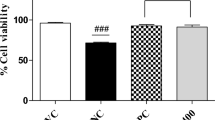Abstract
Enteromorpha compressa a marine green algal species grows extensively in North coastal Andhra Pradesh. Besides its nutritional importance it has also been identified as source of anti-anaphylactic compound(s).E. compressa extracts alleviated the IgE levels raised against ovalbumin and other allergens in mice. Further,Enteromorpha extract also significantly down regulated the serum IgE levels in different murine models irrespective of their genetic background. The results obtained in this study suggest thatE. compressa extract has compound(s), which inhibit IgE immune response and may have potential in curing various types of allergies.
Similar content being viewed by others
References
Chester, C. G. and Stott, J. A. (1964) The production of Antibiotic substances by seaweeds. Proc. Int. Seaweed Symp. 2, 49–53.
Allen, M. B. and Dawson, N. Y. (1960) Production of antibacterial substance by benthic tropical marine algae. J. Bacteriol. 79, 459–560.
Reichelt, J. L. and Borowitzka, M. A. (1984) Antimicrobial activity from marine algae: Results of a large scale screening programme. Hydrobiologia 22, 158–167.
Majin and Tan Wel-Ci (1984) Screening for antimicrobial activities in marine algae from the Quingdao Coast, China. Hydrobiologia 22, 517–520.
Pratt, R., Maurther, H. Gardner. G. M., Sha, Y. and Dufrenoy, J. (1951) Report on antibiotic activity of seaweed extracts. J. Pharm. Ass. Sci. 40, 575–579.
Naqvi, S. W. A. Solimabi, S. Y., Kamat, F. L., Reddy, C. V. G., Bhakuni, D. S. and Dhawan, B. N. (1981) Screening of some marine plants from the Indian coast for biological activity. Bot. Mar. 24, 51–55.
Sreenivasa Rao, P. and Parekh, K. S. (1981) Antibacterial activity of Indian seaweed extracts. Bot. Mar. 24, 577–582.
Padmini, S. R. P. (1992) Biological investigations of India phaeophyceae 10. Seasonal variation of antimicrobial activity of fractions from Sargassum johnstonii setchell et Gardner from Okha, West Coast of India. Seaweed Res. Utiln. 15, 167–172.
Okai, Y. and Higashi-Okai, K. (1997) Potent anti-inflammatory activity of pheophytin-a derived from edible green algae enteromorpha prolifera (sujiao-nori). Int. J. Immunopharmacol. 19, 355–358.
Higashi-Okai, K., Otani, S., Okai, Y. and Hiqashi-Okai, K. (2000) Potent suppressive effect of a Japanese edible seaweed, Enteromorpha prolifera (Sujiao-nori) on initiation and promotion phases of chemically induced mouse skin tumorigenesis. Cancer Lett. 148(1), 111
Umamaheswararao, M. and Sreeramulu, T. (1963) Vertical zonation and seasonal variation in the growth of porphyra on Visakhapatnam coast. Curr. Sci. 32, 173–174.
Umamaheswararao, M. and Sreeramulu, T. (1964). An ecological study of some intertidal algae of the Visakhapatnam coast. J. Ecol. 52, 595–616.
Umamaheswararao, M. and Sreeramulu, T. (1970). An annotated list of the marine algae of Visakhapatnam (India). Bot. J. Linn. Soc. 63, 23–45.
Watanabe, F., Takenaka, S., Katsura, H., Masumder, SA., Abe, K., Tamura, Y. and Nakano, Y. (1999) Dried green and purple lavers (Nori) contain substantial amounts of biologically active vitamin B (12) but less of dietary iodine relative to other edible seaweeds. J. Agric. Food Chem. 47, 2341–3.
Bruijnzeel-Koomen, C., Ortolani, C., and Aas, K. (1995) Adverse reactions to food. Allergy 50, 623–635.
Venkata Raman, B. and Radhakrishnan, T. M. (2002) Anti-anaphylactic activity of Nostoc sps. belonging to Nostacacea. A.P. Akadami of Sciences. 6, 189–194.
Lowry, O. H., Rosebrough, N. J., Farr, A. F. and Randall, R. J. (1951) J. Biol. Chem., 193, 256–275.
Ovary, Z., Barth, W. F. and Fahey, J.L. (1965). The immunoglobulins of mice III. Skin sensitizing activities of mouse immunoglobulins. J. Immunol. 94, 410.
Ovary, Z. (1964) Passive cutaneous anaphylaxis immunological methods, CIOMS, Symposium (Ed. by J.F. Ackroyd) Blackwell Scientific Publications, Oxford. pp. 259.
Salgado, J., Gilbert, A., Castell, M., Castellote, C. and Queralt, J. (1988). Elisa for quantification of specific IgG and IgE antibodies to ovalbumin. Allergol. Immunopathol. (Madr) 16(2), 95–98.
Salgado, J., Gilbert, A., Franch, A., Castell, M., Castellote, C. and Queralt, J. (1989). Effect of adjuvants on IgG and IgE response to ovalbumin in rats. Allergol. Immunopathol. (Madr) 17(5), 237–240.
Birmgham, N., Thanesrorakul, S. and Gangur, V. (2002) Relative immunogenicity of commonly allergenic food versus rarly allergenic and non-allergenic foods in mice. J. Food Prot. 65, 1988–1991.
Kagan, R. S. (2003) Food allergy: An Overview. Environ. Health Perspect. 111, 223–226.
Pereira M. J., Belver, M.T., Pascual, C. Y. and Martin, E. M. (2002). The allergenic significance of legumes. Allergol. Immunopathol. 30, 346–353.
Raghava Rao, T., Rao, D. N., Veerendra Kumar, B., Aparanji, P., Srinivas, K. and Rao, R. A. (2003). Induction of IgE antibody response by the green seed extract of vignasinensis in mice. Ind. J. Clin. Biochem. 18(1), 28–32.
Author information
Authors and Affiliations
Corresponding author
Rights and permissions
About this article
Cite this article
Raman, B.V., Rao, D.N. & Radhakrishnan, T.M. Enteromorpha compressa (L.) Greville an edible green alga as a source of antiallergic principle (S). Indian J Clin Biochem 19, 105–109 (2004). https://doi.org/10.1007/BF02872402
Issue Date:
DOI: https://doi.org/10.1007/BF02872402




